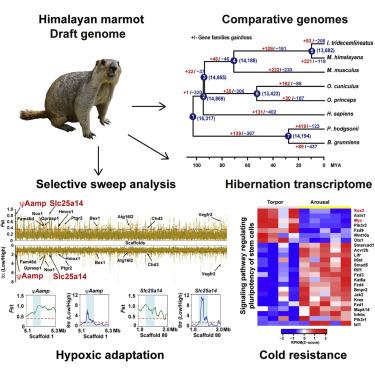iScience ( IF 4.6 ) Pub Date : 2018-12-20 , DOI: 10.1016/j.isci.2018.11.034 Liang Bai , Baoning Liu , Changmian Ji , Sihai Zhao , Siyu Liu , Rong Wang , Weirong Wang , Pu Yao , Xuming Li , Xiaojun Fu , Haiyan Yu , Min Liu , Fengming Han , Ning Guan , Hui Liu , Dongyuan Liu , Yuanqing Tao , Zhongdong Wang , Shunsheng Yan , Greg Florant , Michael T. Butcher , Jifeng Zhang , Hongkun Zheng , Jianglin Fan , Enqi Liu

|
The Himalayan marmot (Marmota himalayana) is a hibernating mammal that inhabits the high-elevation regions of the Himalayan mountains. Here we present a draft genome of the Himalayan marmot, with a total assembly length of 2.47 Gb. Phylogenetic analyses showed that the Himalayan marmot diverged from the Mongolian marmot approximately 1.98 million years ago. Transcriptional changes during hibernation included genes responsible for fatty acid metabolism in liver and genes involved in complement and coagulation cascades and stem cell pluripotency pathways in brain. Two selective sweep genes, Slc25a14 and ψAamp, showed apparent genotyping differences between low- and high-altitude populations. As a processed pseudogene, ψAamp may be biologically active to influence the stability of Aamp through competitive microRNA binding. These findings shed light on the molecular and genetic basis underlying adaptation to extreme environments in the Himalayan marmot.
中文翻译:

喜马拉雅土拨鼠基因组对缺氧和寒冷适应的见解
喜马拉雅土拨鼠(Marmota himalayana)是一种休眠的哺乳动物,栖息在喜马拉雅山脉的高海拔地区。在这里,我们介绍了喜马拉雅土拨鼠的基因组草图,总组装长度为2.47 Gb。系统发育分析表明,大约198万年前,喜马拉雅土拨鼠与蒙古土拨鼠分道扬diver。休眠期间的转录变化包括负责肝脏脂肪酸代谢的基因,以及参与补体和凝血级联以及脑干细胞多能性途径的基因。两个选择性扫描基因Slc25a14和ψAamp显示出低海拔和高海拔人群之间明显的基因分型差异。作为经过加工的假基因,ψAamp可能具有生物学活性,可通过竞争性microRNA结合影响Aamp的稳定性。












































 京公网安备 11010802027423号
京公网安备 11010802027423号